The Marriage of Math and Art in 3D Printing
Finding beauty in geometry has been a lifelong quest for sculptor Bathsheba Grossman.
Latest News
November 13, 2008
By Susan Smith
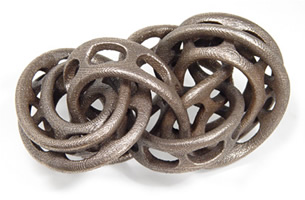 Lazy eight is a technical tour de force: this piece is wildly convoluted, unphotographable, very purely 3D, and unusually comfortable in the hand. Because it interlaces with itself but never quite intersects, it’s slightly springy. |
“I’m an artist exploring the region between art and mathematics,” said Bathsheba Grossman, describing her work. “My work is about life in three dimensions: working with symmetry and balance, getting from a zero point to infinity, and always finding beauty in geometry.”
While at Yale as a student of sculptor Erwin Hauer, Grossman learned about geometrical sculpture. As a math major, she felt this form of expression was for her. “In grad school I studied with his colleague Robert Engman, and from there it was a matter of waiting for the technology to appear that could make the designs I had in mind ... of course there was no particular reason to think it ever would,” recalled Grossman. “I spent a lot of time thinking about things without much expectation that they would be produced other than in handmade one-offs.”
Bathsheba Grossman feels that she was “backed into” working with 3D printing as a way to accomplish her sculptures, because her designs aren’t moldable. She said, “Traditional sculpture methods such as lost-wax casting can’t produce editions of them.” Sculptors who design large, expensive pieces or one-offs do well with those methods, but Grossman said she is a slow designer. “I’ve always preferred that my own work be more affordable, with a large grass-roots customer base. Therefore I needed a production method that’s able to produce quantities of unmoldable designs, and there really is only this one.”
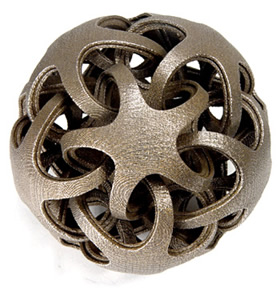 | 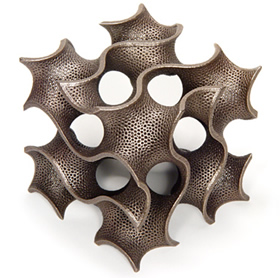 |
| Quintrino is the next member of the Ora family, moving up to dodecahedral symmetry. A mysterious piece with a large and hidden inner volume. | The gyroid is a fantastic triply periodic minimal surface that divides all of space into two congruent regions. |
This one method she refers to is direct metal printing, plus she works with subsurface laser damage in glass. Grossman uses ProMetal, an Ex One LLC company and service bureau, to execute her 3D models. The material used is a composite metal (not an alloy) of about 60 percent steel, 40 percent bronze.
Prior to working with ProMetal, Grossman used a process, which entailed printing models in cornstarch and casting them with lost-wax. “That method had all the problems of 3D printing — mainly fragility and low resolution — plus all the problems of casting,” recalled Grossman.
To begin making a sculpture, Grossman dreams up a shape, and her shapes are quite mathematical in nature. “Maybe a familiar solid such as the cube, or a more esoteric one like the rhombic dodecahedron or one of the zonohedra.” She then uses modeling clay, paper or toothpicks to play with the idea and eventually visualize the sculpture.
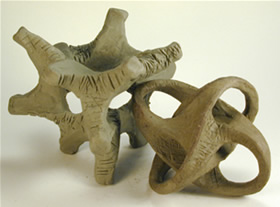 | 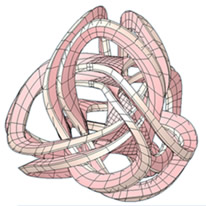 |
| A typical plasticene maquette. There’s much to clean up as the design goes digital. | Wireframe view of the design for AlterKnot. |
Once she has a model whether it’s actually physical or mental, she designs it in CAD software, usually Rhinoceros software, or other software and freeware. Grossman sometimes also writes a utility to facilitate the process.
The ProMetal process involves a basic 3D printing procedure, where the design is laid down, one layer at a time, in stainless-steel powder held in place by a laser-activated binder. Each layer is 0.004-in. to 0.007-in. thick.
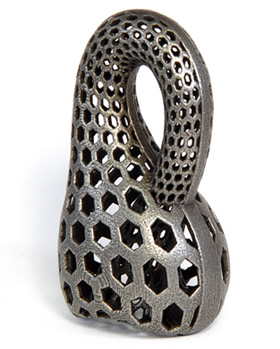 The Klein bottle pictured is an example of a non-orientable manifold without distinct sides; indeed, with only a single side, in short: the Klein bottle opens beers. |
The steel granules are so fine that removing the extra supporting powder from the finished model is easy, and it slides off with a light brush and flows out of interior spaces easily.
For Grossman, the learning curve for 3D modeling was initially steep, and it still remains a time consuming, technical process. Even though this is currently the best method for her sculptures, she said scanning technology can’t (yet) handle the undercutting and interlacing found in her pieces. The material used was designed for injection molding, and lacks aesthetic quality. “This means that even if I’ve got a good physical model, it must be completely rebuilt as a virtual object, because there’s no way to scan it in,” said Grossman. “I do use a Microscribe digitizing arm to help get my maquettes into the computer, and that saves time.” What does suit her work is the geometrical freedom and accuracy of the process.
Challenges with using any type of 3D printing for production, said Grossman, are twofold: to be able to create designs and a marketing strategy that add enough perceived value to the prints to offset their high cost. “It’s easier to do this in metal than in plastic; art buyers like metal,” said Grossman. “It’s also easier if you can sell direct, without the extra 100 percent markup that a gallery imposes. The introduction of Prometal was a lucky moment for me: I had a design portfolio that was well suited to it, and I also had a start in Internet marketing, which was just then taking off.”
 | 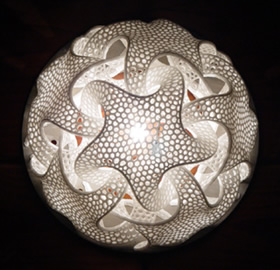 Here are some lighting designs under license to Materialise MGX. They are pioneering the production of designer lighting by 3D printing. |
For these reasons, Grossman feels she has demonstrated that a broad-based consumer market exists for 3D printed products. As a result, there are economic reasons to develop better resolution, more aesthetic materials, and achieve lower costs.
Grossman has also begun to work on more functional designs as she now works with Materialise on their 3D printed lighting line. She is interested in moving into injection molding and other larger-scale manufacturing technologies.
ProMetal
Irwin, PA
Ex One, LLC
Materialise
Leuven, Belgium
Subscribe to our FREE magazine, FREE email newsletters or both!
Latest News
About the Author
DE’s editors contribute news and new product announcements to Digital Engineering.
Press releases may be sent to them via [email protected].






